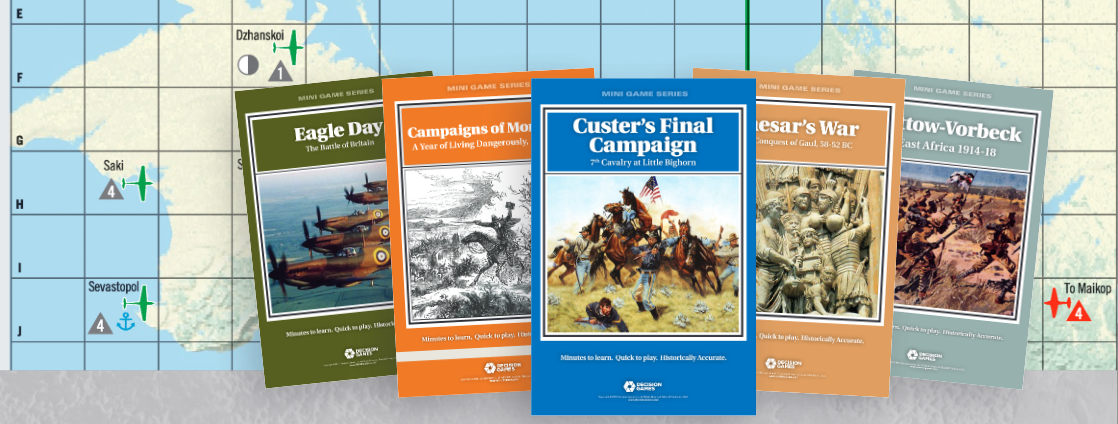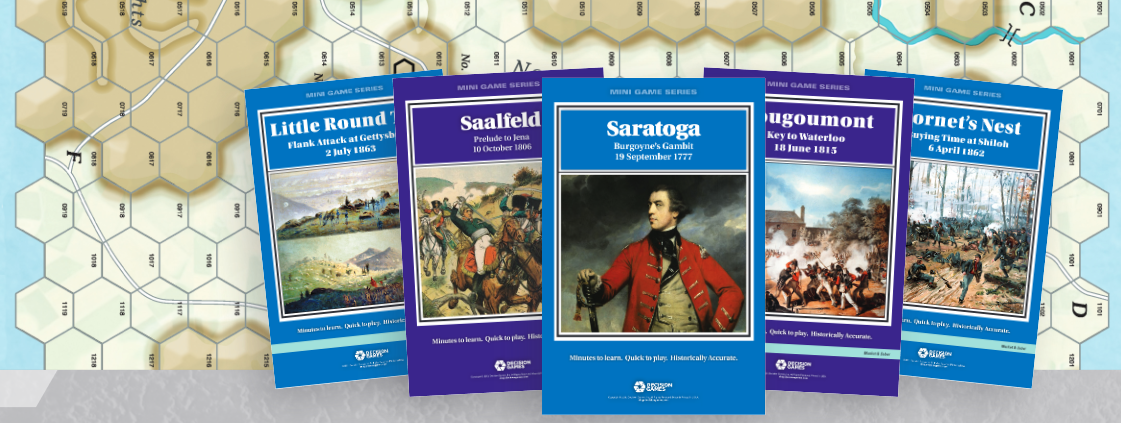Minutes to Learn. Quick to Play.
Historically Accurate.
 Solitaire
Solitaire

Joseph Miranda designed the first two mini-game lines. He designed a line for solo play as well as a line for two players. The solo line places the player in charge of commandos or raiders (units represent individuals up to companies) tasked with various missions they must complete to achieve victory. Each game includes 18 mini-cards. Four mission cards describe the scenario objectives and starting resources. To win the campaign game, the player must win all four scenarios with each succeeding scenario getting more difficult. Fourteen event cards act as a timer as well as generate random events. Games range from Rogers’ Rangers (the first American commandos) to Lawrence (watch the movie while playing the game!) to Khe Sahn (defending a Vietnam-era fire base) to Phobos Rising (a SF theme of Martian commandos attempting to capture key installations at the beginning of an Earth-Mars conflict). Movement is generally point-to-point, and battles are resolved with a simple firefight combat system.
 2-player
2-player

The two-player line has three sub-systems: Ancient Wars, Hand of Destiny (19th century), and Air Wars. Each game includes 18 mini-cards with each player having a deck of nine cards. In Ancient Wars and Hand of Destiny (HoD) the cards indicate the movement allowance of various unit groups as well as reinforcements. In Air Wars, the cards provide an advantage that can be played for one turn or cards can be collected and played to gain a permanent advantage in the game. Ancient Wars and HoD use point-to-point movement, while Air Wars uses a chessboard-like square grid. Air Wars introduces the basics of fighters and bombers with simplified bomb targeting and aerial combat. Some of the Ancient War games include Caesar in Gaul and Hawaii Unification. Hand of Destiny includes Custer’s Final Campaign (the whole year, not just the Battle of Little Bighorn) and Khyber Rifles. Air Wars includes Eagle Day (Battle of Britain) and MiG Alley (Korean War).
 Musket & Saber
Musket & Saber

The third line introduces traditional hex and counter wargaming. The larger group is Musket & Saber Quick Play. It covers small battles and turning points in bigger battles from the 18th and 19th century. The counters represent formations ranging from battalions to brigades and include infantry, cavalry, artillery, and leaders. These formations are rated for how fast they can move, their combat ability, and the morale or elan. Artillery can fire at a distance within its range and cavalry can charge. Units that fail morale checks become disrupted and many units have two strength steps, meaning they can take losses but keep on fighting at reduced strength. Leaders are able to add their movement, combat, and morale values to units in their stack.
Movement is across a hex field and introduces basic concepts of varying cost for entering and crossing terrain (e.g. moving into a clearing costs one movement point while moving into a woods hex may cost two movement points). Combat is largely between adjacent forces (artillery can fire from a distance), and is based on the difference in attacking and defending forces (not the more complex ratio system found in most wargames). Games include entire small battles such as Saratoga (American Revolution) and Salem Church (American Civil War) as well as turning points within larger battles such as Little Round Top (Gettysburg) and Hougoumont (Waterloo).
The M&S Quick Play system rules have received a refresh and the rules are available on the E-rules page of this site and can be used with any game in the series.
Game Systems
Commando
-
Congo Merc: The Congo, 1964

-
Border War: Angola Raiders

-
Merrill’s Marauders: Commandos in Burma, 1943–44

Raider
-
Rogers’ Rangers: America’s First Commandos

-
Long Range Desert Group: Special Operations Against Rommel, 1941–42

-
Lawrence of Arabia: The Arab Revolt 1917–18

-
Heroes of Telemark: Commando Raids in Norway, 1942–43

-
Vikings: Scourge of the North

Cold War Blitz
-
Khe Sanh ‘68: Marines Under Siege

-
Suez ‘56: Anglo-French Intervention

Sci-Fi
-
Ceres: Operation Stolen Base

-
Phobos Rising! Insurgency on Mars

Ancient Wars
-
Caesar’s Wars: The Conquest of Gaul, 58–52 BC

-
Belisarius’s War: The Roman Reconquest of Africa, AD 533–534

-
Hawaii, 1795: Kamehameha’s War of Unification

Hand of Destiny
-
Khyber Rifles: Britannia in Afghanistan

-
Custer’s Final Campaign: 7th Cavalry at Little Bighorn

-
Lettow-Vorbeck: East Africa 1914–18

-
Campaigns of Montrose: A Year of Living Dangerously, 1644–1645

-
Khartoum: Sudan, 1883–1885

Air Wars
-
Cactus Air Force: Air War Over the Solomons

-
Eagle Day: The Battle of Britain

-
Red Eagles: Air War over the Kuban Peninsula, 1943

-
MiG Alley: Air War Over Korea, 1951

Musket & Saber QP (Hex-based)
AMERICAN REVOLUTION BATTLES
NAPOLEONIC BATTLES
19TH CENTURY BATTLES
-
Molino Del Rey: Gateway to Mexico City, 8 Sept 1847

-
Balaclava: Breaking the Siege, 25 October 1854

AMERICAN CIVIL WAR
-
Chantilly: Jackson’s Missed Opportunity, 1 Sept 1862

-
Salem Church: East of Chancellorsville, 3–4 May 1863

-
Mansfield: Crisis in the Pine Barrens, 8 April 1864

-
Wilson’s Creek: Opening Round in the West, 10 Aug 1861

-
Little Round Top: Flank Attack at Gettysburg, 2 July 1863

-
Hornet’s Nest: Buying Time at Shiloh, 6 April 1862


